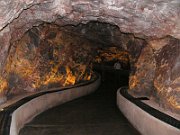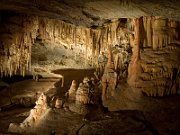Image 1 of 101
John & Val Smart looking good after a winter in the sun
Image 2 of 101
Patiently waiting for our new car audio . . .
Image 3 of 101
The New Musical Instrument Museum - a spectacular place
Image 4 of 101
No question - it's all about music
Image 5 of 101
A Gibson Harp Guitar from 1918
Image 6 of 101
A prototype double-neck with 6 strings on one, 12 on the other
Image 7 of 101
The very rare octobass stands about 11ft tall, and usually takes two people to play it
Image 8 of 101
The 19th century violin is porcelain, the 20th century trumpet is glass
Image 9 of 101
When Samurai were outlawed in Japan, many became wandering Komuso monks who played the shakuhachi flute for alms
Image 10 of 101
Very pretty, potentially very loud
Image 11 of 101
Tuned granite
Image 12 of 101
Many of the instruments are works of art
Image 13 of 101
Gourds are often used as resonators in many parts of the world
Image 14 of 101
Video displays showed many of the displayed instruments being played
Image 15 of 101
Variations on bowed strings are widespread
Image 16 of 101
A Tuvan (Southern Siberia) rattle made from a bull scrotum
Image 17 of 101
If you can bang it, blow it, pluck it, bow it, strum it or shake it, somebody somewhere will make music on it
Image 18 of 101
Some national collections are very complete
Image 19 of 101
Lots of xylophones are played sitting or kneeling
Image 20 of 101
Some instruments you practically have to live in
Image 21 of 101
Many are wonderfully decorated
Image 22 of 101
These drums you play from the inside
Image 23 of 101
Boat lutes are usually made from a single piece of wood
Image 24 of 101
Oriental instruments are often the most elaborate
Image 25 of 101
The palm leaves are the sound box for the plucked strings around the center pillar of the Sasandu from Tenggara (Indonesia)
Image 26 of 101
The sounds are spectacular as well
Image 27 of 101
The Paraguayan Harp is beautiful
Image 28 of 101
Tuned pieces of hollow reed make up these multi-pipe Peruvian flutes
Image 29 of 101
Some instruments are less portable than others
Image 30 of 101
When in need, any resonator will do
Image 31 of 101
The Berimbau is a musical bow, used in a martial arts dance form
Image 32 of 101
You wear the turtle shell, and play it with the antlers.
Image 33 of 101
The Marimba, in many forms, is very popular in Latin America
Image 34 of 101
Some are more ornate than others
Image 35 of 101
Western instruments introduced to Latin America were often localized
Image 36 of 101
In the Caribbean, you pretty much play what you have
Image 37 of 101
Including tuned tin cups
Image 38 of 101
The video shows Dizzy Gillespie and his distinctive (but not unique) trumpet
Image 39 of 101
Native American ceremonial drums are played by several drummers
Image 40 of 101
The Steinway folks show the innards of a grand piano
Image 41 of 101
As cultures blend, instruments are adapted
Image 42 of 101
Horns of every size . . .
Image 43 of 101
A 19th century American parlor . . .
Image 44 of 101
The Grand Harmonicon - tuned glasses, played with the fingers
Image 45 of 101
Never actually saw a double-bell euphonium before . . .
Image 46 of 101
A rare video of John Phillip Souza conducting one of his marches
Image 47 of 101
Another rare video of Leon Theremin playing his invention, one of the first electronic instruments
Image 48 of 101
One of the earliest portable music synthesizers
Image 49 of 101
A luthier's shop - for making guitars, the modern version of the lute
Image 50 of 101
The monochord - you bow the single string, and work the keys with your left hand
Image 51 of 101
The serpent, from 1820's England, is a predecessor to the tuba
Image 52 of 101
It's sad you can't see an alpenhorn without somebody saying "Ricola" . . .
Image 53 of 101
Most European instruments are variations on each other
Image 54 of 101
From Sweden, the Harjedalspipa or Nyckelharpe is a variation on the keyed violin
Image 55 of 101
The Lur was a 7th century Scandinavian signaling horn
Image 56 of 101
We like most balalaika music. They come in all sizes
Image 57 of 101
Comparing musical instruments illustrates cross-cultural influences
Image 58 of 101
In some cases, the instruments of a country are displayed in a single panel
Image 59 of 101
Some of the gourd xylophones are amazingly ingenious
Image 60 of 101
Judy has an African Kalimba, one of many variations on a Lamellaphone
Image 61 of 101
This one used hacksaw blades to make the sounds
Image 62 of 101
Tuned Kudo horns . . . side-blown trumpets
Image 63 of 101
More lamellaphones
Image 64 of 101
Early 20th century arched harps from the Congo
Image 65 of 101
Yet another reason to "Shake a leg" . . .
Image 66 of 101
The marvelous inlays on this Egyptian lute are actually plastic
Image 67 of 101
Bagpipes from the Black Sea region
Image 68 of 101
Very pretty - but how would you hold it?
Image 69 of 101
Moving on to dinner, and the magnificent Wurlitzer at the Organ Stop Pizza
Image 70 of 101
This obviously traumatized cactus was fascinating . . .
Image 71 of 101
First Presbyterian in Casa Grande is a church we like
Image 72 of 101
That's why most folks come to Tombstone . . .
Image 73 of 101
The former corral is filled with pseudo-historic exhibits
Image 74 of 101
"Doc Holliday" explains what's going to happen - in verse - imbibing all the while
Image 75 of 101
Nobody's wearing white hats, but it's Earps on the left, Clantons on the right
Image 76 of 101
Now it's Earps on their feet, Clantons on the ground
Image 77 of 101
We didn't take any of the rides
Image 78 of 101
We did tour the newspaper museum
Image 79 of 101
Al took printing in high school, and all this stuff is familiar
Image 80 of 101
In fact, all this historical gear is identical to what he used. Ergo, Al is historical?
Image 81 of 101
The rest of us just come on in . . . .
Image 82 of 101
OK, so that's not historical. What a way to make a living . . .
Image 83 of 101
The main drag thru Tombstone is closed to "modern" vehicles most of the time
Image 84 of 101
Tombstone was hosting a quick-draw competition - lots of machoness about
Image 85 of 101
Neat bench . . .
Image 86 of 101
Some streets are named after the old mines
Image 87 of 101
There were about 15 of us toured the mine
Image 88 of 101
We had to wear hard hats (from the rack by the wall) because of low clearances
Image 89 of 101
There was lots of old mining equipment scattered around
Image 90 of 101
That was the original mine entrance . . .
Image 91 of 101
The mine is still shored up with some of the original timbers after 100 years
Image 92 of 101
Rocks without silver content were often piled up in played-out tunnels
Image 93 of 101
Remnants of a burlap sack used to haul the ore to the surface. On a miner's back, usually
Image 94 of 101
For two bucks, we got to see "The Worlds Largest Rose Bush"
Image 95 of 101
It's actually quite pleasant in that yard under the bush
Image 96 of 101
The bush was very much in bloom, and the fragrance was delightful
Image 97 of 101
They say it covers about 8,000 sq ft on that trellis
Image 98 of 101
One of the prettiest caves we've ever toured . . .

Image 99 of 101
Internet photo, showing the curbed, accessible walkways thru the caves

Image 100 of 101
Internet photo - the formations are delicate and pristine

Image 101 of 101
We'll end on the Big Room - one of the most spectacular places in the caverns (internet photo)